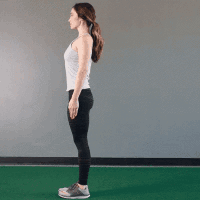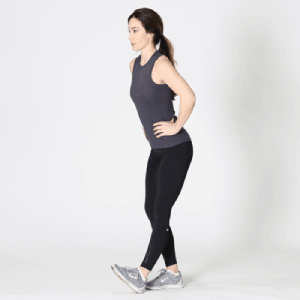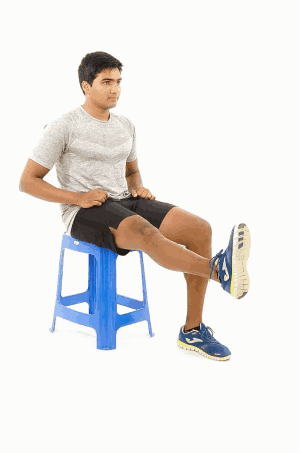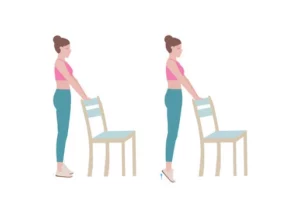It’s a familiar sensation for many: settling into your office chair or sinking into the couch after a long day, only to feel that telltale twinge in your knee. As the minutes tick by, that mild discomfort escalates, transforming your moment of relaxation into a period of restless adjustment. If you’ve found yourself asking, “Why does my knee hurt when I sit?“, you’re not alone. In this comprehensive guide, we’ll dissect the causes of knee pain when sitting, and arm you with strategies to reclaim your comfort and maintain your knee health. Dive in, and let’s get you sitting comfortably again.
Contents
What Causes Knee Pain While Sitting?

Sitting may seem like an innocuous activity, but for many, it can be a surprising source of knee pain. The roots of this discomfort are multifaceted and can stem from various sources:
Prolonged Immobility
When we sit for extended periods, our knees remain bent in a fixed position. This static posture can restrict blood flow and cause stiffness in the surrounding muscles and ligaments, leading to discomfort or pain when we finally move.
Previous Injuries
Past traumas to the knee – be it a sprain, ligament tear, or fracture – can leave behind residual pain that becomes prominent when sitting. The stationary position might aggravate old injuries, causing intermittent flare-ups.
Patellofemoral Pain Syndrome
Commonly termed “runner’s knee,” this condition involves pain around the kneecap (patella). It’s caused by the misalignment of the kneecap or overuse from activities like running and jumping. Sitting for long durations, especially with a bent knee, can exacerbate this pain.
Osteoarthritis
This degenerative joint disease involves the wear and tear of the knee’s cartilage. Sitting can increase the pressure within the knee joint, and for those with osteoarthritis, this can mean intensified pain.
Poor Posture and Ergonomics
If you’re slouched in a chair or sitting without proper support, your entire body alignment can be affected, including your knees. Inadequate chair height or lack of foot support can force your knees into awkward angles, leading to discomfort.
Bursitis
The knee contains small fluid-filled sacs called bursae that act as cushions between bones and soft tissues. Inflammation of these bursae, known as bursitis, can cause pain when the knee is bent for prolonged periods.
Meniscus Tears
The meniscus is a C-shaped piece of cartilage that acts as a cushion between the thigh bone (femur) and shinbone (tibia). A tear in this cartilage can cause pain, especially when maintaining a bent-knee position.
Understanding the root cause of your knee pain is essential. It not only helps in targeted pain management but also provides insights into preventive measures that can be incorporated into daily life.
How Sitting Habits Impact Knee Pain
 Often, when considering knee pain, our minds immediately jump to high-impact activities or previous injuries as the culprits. However, something as basic as our sitting posture can play a pivotal role in the onset and exacerbation of knee discomfort.
Often, when considering knee pain, our minds immediately jump to high-impact activities or previous injuries as the culprits. However, something as basic as our sitting posture can play a pivotal role in the onset and exacerbation of knee discomfort.
- The Mechanics of Sitting:
When we sit, the angles and pressures within our knee joints change. This is especially true if we’re frequently seated with knees at a right angle or worse, crossed over each other. - The Cascade Effect:
Slouching in a chair doesn’t just affect your back—it creates a domino effect. A hunched back can lead to a tilted pelvis, which in turn can misalign the knees and even the ankles. This misalignment, over time, can amplify knee pain, especially when sitting. - Leg Positioning:
Hanging feet or tucking them under the chair? Both these positions can place added stress on your knees. Ideally, feet should rest flat on the ground, supporting proper leg alignment. - Seat Edge Pressure:
Sitting at the edge or too forward on a chair can apply pressure to the hamstrings’ underside. This pressure can pull the knee joint, causing pain or discomfort over prolonged periods. - The Importance of Lumbar Support:
Adequate lower back support can make a world of difference. When the lumbar region is supported, it promotes an upright posture, ensuring the knees are positioned comfortably and reducing strain. - Ergonomics Matter:
The design of your chair and workstation plays a vital role. Chairs with adjustable height, depth, and proper cushioning can reduce the risk of knee pain. Similarly, ensuring that your computer or work desk is at the right height can prevent you from leaning forward, maintaining a better overall posture.
In essence, while the knee might seem distant from our core and upper body, the relationship between posture and knee pain is profound. Small adjustments to how we sit can make a significant difference in managing and preventing knee pain. Remember, it’s not just about sitting right—it’s about sitting smart.
Simple Adjustments for Immediate Relief
 Experiencing discomfort while seated? These minor modifications can make a world of difference to your knees:
Experiencing discomfort while seated? These minor modifications can make a world of difference to your knees:
- Utilize a Footrest: If your feet don’t comfortably reach the ground, use a footrest. This supports better knee alignment and reduces strain.
- Reposition Your Legs: Shift your legs periodically. Avoid crossing them, and try to keep them at a right angle or slightly extended.
- Adjust Chair Height: Make sure your chair is at a height where your feet rest flat on the ground, with your knees and hips aligned at approximately 90-degree angles.
- Cushion Support: Consider placing a cushion or folded towel behind your knees to reduce pressure. It can make sitting more comfortable, especially if you’re experiencing pain.
- Stretch Periodically: Every 30 minutes, take a short break to stand and stretch. Simple stretches can alleviate tension and prevent stiffness.
- Avoid Sitting Too Long: Whenever possible, stand up and move around for a few minutes. Continuous sitting can exacerbate knee pain.
With these proactive measures, you can foster an environment that caters to knee health, even when seated for extended periods.
Stretching and Exercise for Relief
Here are some beneficial stretches and exercises tailored for those who often find themselves seated for prolonged periods:
Quadriceps Stretch

- Stand upright next to a wall or chair for balance.
- Bend one knee, bringing your heel towards your buttock.
- Hold your ankle with the same-side hand, pulling it gently closer while keeping your knees together and pelvis tucked.
- Hold for 20-30 seconds and switch legs.
Hamstring Stretch

- Stand straight with one leg leg extended straight in front of you.
- Flex your foot (toes pointing upwards).
- Hinge forward at the hips, keeping your back straight until you feel a stretch along the back of the extended leg.
- Hold for 20-30 seconds and switch legs.
Seated Knee Extension

- Sit upright in a chair with both feet flat on the floor.
- Slowly extend one knee, raising your foot until the leg is straight. Hold for a few seconds.
- Lower the foot back to the floor. Repeat for 10-15 times and switch legs.
Calf Raises

- Stand upright, holding onto a wall or chair for balance.
- Lift both heels off the ground, standing on your toes.
- Slowly lower your heels back to the ground. Repeat for 10-15 times.
Hip Flexor Stretch

- Stand in a lunge position with one foot forward and the other extended back.
- Tilt your pelvis and push your hips forward slightly until you feel a stretch in the front of the hip on the extended leg.
- Hold for 20-30 seconds and switch sides.
Incorporating these stretches and exercises into your daily routine can help counteract the effects of prolonged sitting. Remember, consistency is key. Even a few minutes of stretching daily can contribute significantly to knee health and overall well-being.
Signs It’s More Than Just Sitting Pain
While occasional knee discomfort after prolonged sitting can be typical, certain signs might indicate an underlying condition or a more significant issue. Here’s when you should be more concerned:
- Consistent Swelling: Occasional swelling might be normal, but if your knee remains swollen despite rest and over-the-counter treatments, it could signal a deeper problem.
- Pain that Persists: If the pain doesn’t ease after a few days of rest, exercises, and stretches, or if it’s recurrent, it might be time to seek a professional opinion.
- Limited Range of Motion: Struggling to fully straighten or bend your knee can be a sign of a potential joint or ligament issue.
- Locking or Buckling: If your knee occasionally locks up or gives way when you stand or walk, it could indicate cartilage damage or a ligament tear.
- Unusual Sounds: Grinding, popping, or clicking sounds in the knee during movement might hint at damaged cartilage or misalignment.
- Pain even at Rest: If your knee hurts even when you’re not moving or putting weight on it, this could be a sign of an inflammatory or degenerative condition.
If you experience any of these signs consistently, it’s crucial to consult with a healthcare professional to determine the cause and receive appropriate care.
Professional Interventions for Chronic Issues
 For those who experience chronic knee pain while sitting, occasional stretches or posture adjustments might not be enough. Persistent pain can be a sign that there’s a deeper issue at play, requiring more advanced interventions. Here’s a glimpse at some of the professional treatments and therapies available for chronic knee pain:
For those who experience chronic knee pain while sitting, occasional stretches or posture adjustments might not be enough. Persistent pain can be a sign that there’s a deeper issue at play, requiring more advanced interventions. Here’s a glimpse at some of the professional treatments and therapies available for chronic knee pain:
- Physical Therapy: Tailored exercises and stretches guided by a physical therapist can address specific pain points, improve joint mobility, and strengthen the surrounding muscles.
- Joint Injections: Depending on the underlying cause, corticosteroid or hyaluronic acid injections can be administered directly into the knee joint to reduce inflammation and pain.
- Orthotics and Braces: Custom-made orthotics or knee braces can help in distributing pressure, offering support, and ensuring better alignment of the knee joint.
- Regenerative Medicine: Techniques like Platelet-Rich Plasma (PRP) injections utilize the body’s healing mechanisms to promote recovery and reduce pain.
- Medication: Anti-inflammatory drugs or pain relievers can be prescribed to manage pain and reduce inflammation.
- Surgery: In extreme cases where damage is extensive or other treatments are ineffective, surgical interventions like knee replacements might be considered.
It’s essential to consult with orthopedic specialists or other medical professionals to determine the most appropriate intervention for your specific condition.
Conclusion
Knee pain while sitting, though seemingly innocuous, can be a clear signal from our body about underlying issues or poor habits. Whether it’s a result of poor posture, extended periods of sitting, or a more profound medical condition, it’s crucial to heed these signs early on. By understanding the causes, implementing preventative measures, and seeking the right treatments, you can ensure a more comfortable and pain-free experience in both work and relaxation settings.
Remember, if knee pain persists or if you’re looking for a specialized approach to address your discomfort, PhysioMantra is here to assist. If you’re experiencing Knee pain, physical therapy for knee pain at PhysioMantra can help: Book an online physical therapy session.



